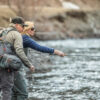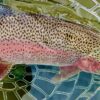Synopsis
As August comes to a close, Angling in and around the Wood River Valley continues to be very good. The morning activity at Silver Creek remains consistent and terrestrial fishing is still producing well in the afternoons. The Big Wood, Big Lost, South Fork of the Boise and the Salmon Rivers are also fishing well with good dry fly fishing throughout the day. Look for fishing on our local freestones to improve with the onset of cooler nighttime temperatures and the appearance of larger insects, such as the Red Quill. If you haven’t had an opportunity to pick up a fly rod this summer, don’t worry, autumn is one of the best times of the year to chase the wily and hungry trout.
Silver Creek
The Creek continues to offer good activity for early to rise fishermen. The Tricos (size 20) have begun to dwindle although some mornings, depending on the stretch of river you choose to fish, these petite mayflies will still have a significant presence. Make sure you also come well-equipped for the Baetis emergence (size 20-22), as this is the main morning food source for the Rainbows and Browns of Silver Creek. Callibaetis (size 16) are also becoming more numerous on this spring creek, a welcome treat for those of us who have been straining our eyes to see our minuscule Baetis and Tricos. The Callibaetis should grow in number into September making for some superb angling on both the moving and still water sections. In the afternoons once the mayfly activity calms, try throwing grasshoppers near the banks on 3X or 4X tippet or use Crow Beetles (sizes 10-16).
Big Wood River
The Big Wood is fishing well as Pink Alberts (size 16), Baetis (sizes 18-20), Yellow Craneflies (size 14) and a multitude of Caddis are the flies of choice. Try casting a Spruce Moth (Beige Elk Hair Caddis size 14) as your first selection or a Parachute Adams (sizes 16-18). The caddis will elicit the most aggressive strikes while the mayfly imitation will be another impressive producer for those who wish to fish on the surface. Afternoons see an abundance of riverside grasshopper activity and hopper imitations can bring some of the larger trout to the surface. If fishing slows in the afternoon, add a midge pupae to your grasshopper in an attempt to present a fly down deep. Black, brown and red Zebra Midges are good choices as well as Caddis Pupae (size 12-16) or mayfly nymphs (sizes 16-18).
Big Lost River
The Lost is fishing well both sub-surface and on top. Below the Mackay Dam expect to find success primarily underwater with small black or red Zebra Midges trailed behind larger mayfly nymphs. Prince Nymphs, King Princes, Copper Johns and Pheasant Tails (size 14-18) can be effective. Cranefly patterns such as the Mackay Special, if fished in a quartering-down fashion and skated across the river, will bring some of the larger Rainbows to the surface. Above the reservoir try Parachute Adams (size 16-18) as well as Tricos (size 20). Blue Winged Olives (size 16) will appear as the fall progresses, but for the moment use grasshoppers trailing mayfly nymphs, midge pupae or caddis pupae in a variety of sizes.
Upper Big Lost
The West, East and North Forks of the Big Lost continue to fish well with large cream Caddis eliciting aggressive strikes from Rainbows, Cutthroat, Cuttbows, Brook Trout and Whitefish. As another option in the morning hours try Parachute Adams (sizes 16-18). The Caddis become present in large numbers in the evening but fish will take them all day long. Tricos (size 20) and Pink Alberts (size 16) are prevalent in the mornings and sipping fish are likely to take a well-presented fly. Grasshoppers are another productive choice but I would hedge toward Caddis and Mayflies first. September 1st is about the time that trout begin to migrate downstream from the upper reaches of this river system as nighttime temperatures drop below freezing and food sources begin to wane. Fishing is still productive to the top of the system but in a few short days this will begin to change.
South Fork of the Boise
The South Fork of the Boise has recently been dropped to approximately 600 cfs. This can change daily but should remain fairly consistent for the next couple weeks. Make sure to check the Streamflow Report for real time flow reports before you head out. Pink Alberts (size 16) are the imitation of choice on this tailwater. Grasshoppers are another productive selection especially during the afternoon hours. Woolly Buggers and Streamers are always good choices as are mayfly nymphs (size 16) trailed off of foam Hoppers.
Salmon River
The Salmon continues to fish well for Rainbow and Cutthroat trout as well as for Whitefish. The high activity we saw two weeks ago has passed but fish are still eating Spruce Moths (cream Elk Hair Caddis size 12) regularly. Black Flying Ants (size 12) will bring some fish to the surface but expect to see a more significant dependence on nymphing as we head into September. Be aware that the Chinook Salmon are now spawning and floating is closed from Buckhorn to Stanley, Mormon Bend to the Yankee Fork and Torrey’s downstream toward Squaw Creek.



